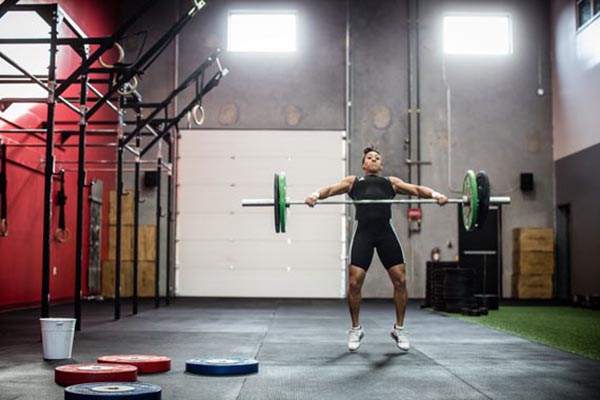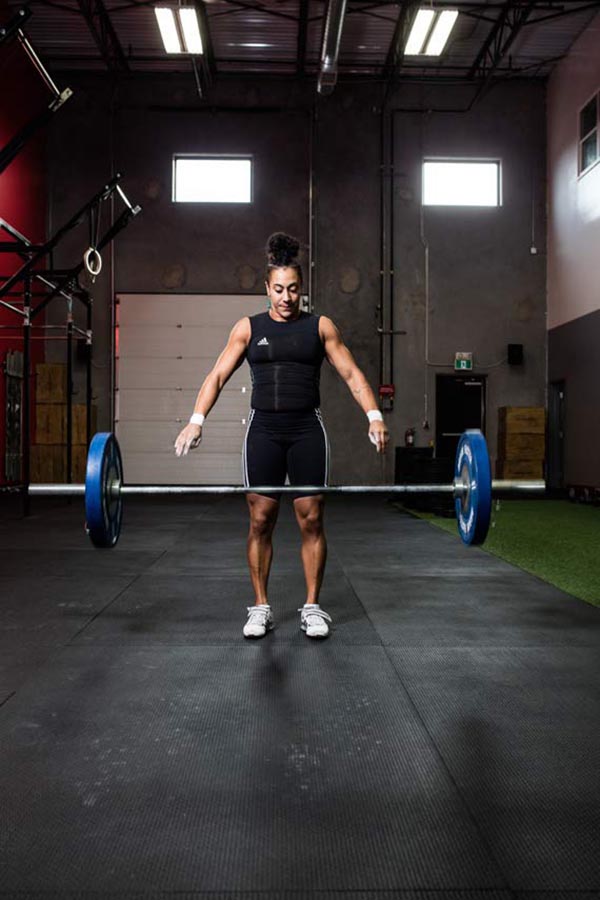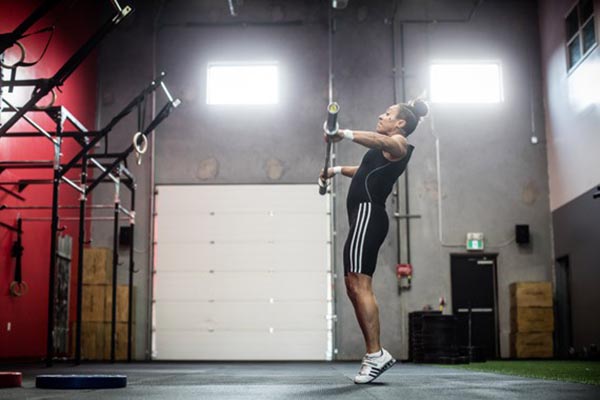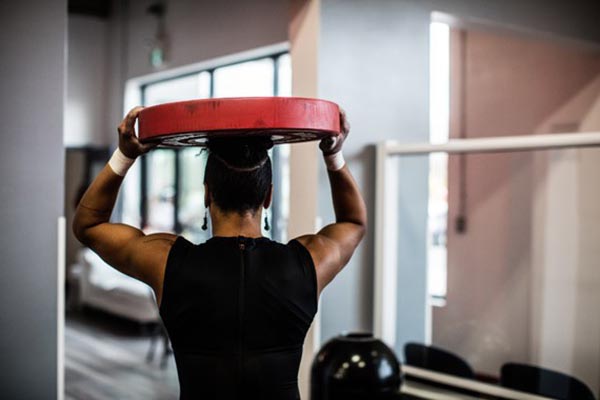Mel Clarke is at the 2015 Canadian Senior Weightlifting championships. It’s her second weightlifting competition ever. Earlier, before the panel of judges, she weighed in at 57.4 kilos—just over 126 pounds. She had qualified for nationals by power-jerking 185 pounds above her head with elbows locked. At that provincial qualifier, last November, nagging hip and wrist injuries meant she couldn’t lift from the usual squat position. But her 185-pound power-jerk, combined with a power-snatch at 145 pounds, meant Clarke qualified in the A-Class, the group above her weight class.
It was her first weightlifting competition ever.
At the national competition in Mississauga last May, Clarke’s wrist was still bothersome. The judges wouldn’t allow her to wear a brace. Her warm jokes to judges and competitors weren’t exactly well-received. “Take it down a notch, Mel,” they said. And at that point, she realized the seriousness of these competitions. “I’m such a typical east coaster,” she thought. Nationals weren’t like the more casual CrossFit trials she’d been competing in the last couple years. The Quebec team, especially, did not get her jokes.
But she wasn’t nervous. She wasn’t intimidated. She wasn’t even scared. She was wearing a Team Maritimes shirt, but there wasn’t a team. Just a year into weightlifting, Clarke was competing with some of the country’s strongest athletes, like Pan American Games Team alternate Lacey Van Der Marel. And she alone was representing women weightlifters from Nova Scotia.
However, she wasn’t completely on her own. The Nova Scotia Weightlifting Association had sent a coach and lifter named Isaac Smith to accompany Clarke at nationals. During Clarke’s warm-up, Smith sensed that he had the skills needed to help her. He took over coaching her on the spot. They gelled immediately.
Now Clarke was calm. She took a deep breath. With chalky hands, she approached the platform that held the 145-pound barbell.
When she lifted, “she was just raw power, she attacked it,” Smith says. “And she was fearless.” Clarke snatched 145 pounds, and then 154 pounds. Next she clean-and-jerked 198 pounds, then 205. Smith, calculating in the moment for the best advantage in the final lift, told Clarke that if she made 218 pounds, she’d place third overall.
“I had never lifted 218 in my life,” Clarke says. “But I said, ‘Yeah sure! Whatever you put on the bar, I’m going to try and lift.'” She made the lift to her chest, but just as she raised the weight, her elbow bent and the lift was incomplete. She placed fifth overall. “But it was great, it was fun,” she told Smith backstage.
Later a judge asked her, “Where’d you learn to lift like that? How long have you been doing this?”
“A year,” she replied. He shook his head in admiration. Another coach from Saskatoon said with her skills and natural strength, she could win her category in the next few years.
That was six months ago. On Saturday, Clarke will compete in the provincial championships in Dartmouth. At 32, she’s the best female lifter in the Maritimes. “Watching her lift at nationals was a pioneering moment for Nova Scotia weightlifting,” says Smith. “Mel had been a role model to so many already.” At provincials, she says, “I just want to qualify for nationals in my first lifts, that’s my goal.”
Originally from PEI, Clarke was naturally athletic. She played for Dalhousie University’s women’s soccer team through her university career. And for a while, the team vibe suited her.
“In team sports, I liked to hide. I never liked to be the centre of attention. And as a team, we were a back-to-back national-winning team,” Clarke says. But despite that success, she never felt she was giving the sport 100 percent. “I thought soccer was my thing, but when I left Dal, I thought, how come I didn’t try harder? I know I had more in me. I know I could have worked harder. I had been invited to high-level tryouts,” she remembers. “But there’s a difference between doing something you’re good at and doing something you love. And I love lifting. And I know I love it because I love coaching it.”

About five years ago, while playing soccer for the Halifax Dunbrack women’s team—which won gold at the 2010 BMO Championships—Clarke started training CrossFit in Halifax’s north end. CrossFit is a competitive fitness sport invented by two Americans in 2000, and it’s grown in popularity. It blends elements of high-intensity training, gymnastics and weightlifting with timed individual workouts. That aspect of competition was appealing to Clarke. And CrossFit was so different from soccer—individuals competed against their own statistics and attempted to improve their own performances, but it’s also a team environment, a supportive community. And more than not, CrossFit is a lifestyle. Focusing on strength and power rather than teamwork, Clarke realized she was great at it.
She started competing in local and national CrossFit competitions, and because it’s such a supportive atmosphere—peers cheering on peers—Clarke realized she also loved coaching.
“Soccer had made me coachable, because I listen. Someone tells me to do something, I work until I do it, and being coachable means you can coach, as well,” she says. She soon obtained her Level 1 Certificate to coach CrossFit. And because a large part of the CrossFit program involves the two competitive weightlifting moves—the snatch and the clean-and-jerk—Clarke’s explosive strength and power were incredible assets. “I was super-strong, that was a given when I started—I’ve always been strong—and I was excelling in lifting. It became my favourite part.”
“So I took a step back from CrossFit and took a weightlifting course taught by the Nova Scotia Weightlifting Association. I thought, Maybe I’d like to do this because it will help me do CrossFit better and it will help me be a better coach.”
Taught by Canadian weightlifting coaches in Fredericton, she walked into the course and thought, “Oh my god, this is a whole other world, and I’m super-interested. I wanted to be a better coach, I was teaching these lift movements in class, but it blew my mind how little I knew about them and how little I knew about the sport of weightlifting itself—the kinetics of it, how the sport worked, the skill. It’s so highly technical and so many parts make up one or two movements. It’s also really involved as far as strategic planning.”
In competitive weightlifting, athletes have to complete in both the snatch and the clean- and-jerk. They have three attempts for each lift style, and the two top successful lifts of each set comprise the overall score. The competitive edge in weightlifting is not only strength but strategy—calculating each lift so that the lifter has the best chance of earning a higher total than her competitors. But athletes don’t know the maximum lift capabilities of other competitors. And Clarke also learned that finesse is everything.
“In CrossFit, you might just complete the lift without form and think, well that’s a good rep, but in weightlifting, you have to stay within the platform, you can’t bend your elbow at all, you’re being watched by highly trained judges, and if the bar comes off your chest, it’s a no-lift,” she says. “So even if you make the lift, you might not make the lift, you see? And to me, that was another challenge of this sport that I wanted to take on. Because it takes so many things aligning in your body and mind for that weight to go up over your head and to click into place. And when you put it all together and it works, it feels amazing, it feels weightless.”
Around this time, just over two years ago, Clarke’s friend Dave Rafuse opened Blended Athletics in Dartmouth, a lifting and CrossFit training centre of his own. Once established, he invited Clarke to teach there. Within six months, she had developed her own weightlifting training class called Mel’s Belles. Rafuse helped her market it. At first it was just for women, but soon men wanted to train with her, too.

“I hear people say, ‘Wow, this is so much harder than I thought,’ all the time,” she says. “And I’m like, yeah that’s my life, that’s my training. It’s every single part of the lift: getting the bar from the floor to your knee, from your knee to above your knee, from above your knee to your hip, what happens from your hip to your chest. Then to get that bar over your head, every single step is a million things to think about. And to do it all right, and because it all happens in two seconds and in one movement, it’s really beautiful. It’s an art form. It takes so much skill.”
“She wants the national team, with Canada on her singlet,” says Smith. “She is a raw athlete, and much stronger than most of the athletes she competed against last year.”
Coach Smith explains the different purposes of competitive lifts. The snatch is designed to be fast and light, while the clean-and-jerk is slower but heavier. “Mel can out-snatch what individuals can clean-and-jerk, even two to three weight-classes higher than her own, and as much as some of my guys. She’s brutally strong.” He guesses the average female lift in Clarke’s weight class is 55 to 60 kilos.
“Mel can snatch up to 77 kilos consistently,” he says, about 170 pounds. But believe her, she works for it. When she’s not coaching at Blended Athletics or teaching Mel’s Belles most days of the week, she’s training her own lifts five to six days for two to three hours per day, with a rest day that usually involves some light cardio.
“For training, I do my lifting, I do CrossFit training because I still really like it, and then I do what I call accessory work, things you’d see bodybuilders do,” she says. “And it’s basically to condition small, specific muscles that are the stabilizing muscles I need to hold weight over my head.”
She says weightlifting requires a strong back, chest and shoulders.
“Legs, thighs are a huge part of it, that’s the benefit of being a soccer player, and hip strength, too,” she says. “In a lift, it’s strength, strength, strength, explosiveness, strength. Lifting is the zen part of my day, it’s taught me so much other sports haven’t. I would have been a better soccer player or student or employee if I knew these things, because it taught me patience and skill. In soccer, I never valued finesse as much as I valued power. So that’s been another challenge for me, to slow down and refine it.” It’s been an interesting transition from team sports to solo performances.
“It’s just me and the bar and people watching me. You have to trust yourself,” she says. “Now when I walk out on that platform, I feel the best I’ve ever felt.”
Much of Clarke’s confidence is drawn from her ideology about sport and about women in sport. While men’s weightlifting has existed since ancient Greece and in the Olympics since the 1890s, women’s Olympic weightlifting was introduced at the 2000 Olympic Summer Games in Sydney, Australia. That’s only 15 years, and interest in the sport is relatively new but it’s growing. Clarke says starting Mel’s Belles just for women was an attempt to make women feel comfortable with the idea of weightlifting. Ask any female. Entering a weight room full of men can be really intimidating.

“There is so much machismo in the gym,” explains Clarke, citing franchise fitness centres and Dalplex as unwelcoming towards women in weight rooms. “I just felt like I didn’t belong in those places, and I ended up doing elliptical workouts because that’s what most of the girls did, and that’s when I realized I wanted to change that.”
She says even as a Dal soccer player, she felt that the women’s varsity teams weren’t treated with the same attention as men’s. “We were a much better team than the men’s team and we were treated like less, and it took me awhile to realize I’ve always been a feminist, I just didn’t know it,” she says. “I just remember being young and being treated really differently in my sport, and being so hurt and so angry about that, not knowing that I just wanted equality. That’s what feminism is. So when I came into Blended Athletics, I was like, I am not going to let women feel that way. I want them to feel empowered. If they’re good or lift more than a man, I don’t want them to have to apologize for it.”
Sometimes men see Clarke lift, and they remark,”‘Oh, you’re making me feel bad about myself.’ Well, that’s not my problem, man,” she says, laughing. “So that was something I wanted to change, and I wanted to encourage women to lift, and take control of what they’re doing in the gym so that when they walk into the gym, it’s their gym, too.”
Blended Athletics and CrossFit are gender-inclusive spaces, for the most part. Clarke tells the story of her friend, a transgender woman, who wasn’t able to participate in CrossFit women’s competitions, but was accepted into women’s weightlifting. She’s doing well in lifting. Clarke says CrossFit is increasingly attracting African-American athletes, and she says every person can find a representative of their culture or gender in weightlifting around the world. The sport is especially popular in China, Eastern Europe and the US.
But without generalizing, she still notices differences in the way that men and women respond to coaching. “I’m one of the head coaches at my gym, and I think I’m a really good coach, and I still sometimes find it difficult to say to to certain guys, ‘Take the weight down, you’re not doing that properly,'” she says. “One guy left our gym because he didn’t want to be coached by a girl but, you know, that’s fine with us. I also notice I have to encourage women more, like, ‘You need to trust yourself, your technique is beautiful, your strength is there, you can actually go up in weight.’
“I know these behaviours are totally socially and culturally shaped, but we can relearn them. You have to listen to your coach to avoid injury. It also takes a lot of guts to go for max lifts. In these worlds, which are inclusive, you have to accept this equality. And it’s not a power trip, it’s just equality. And that’s why I feel, for young women, the sports of weightlifting and CrossFit can change your world.”

In the weeks leading up to provincials, Clarke trims out calories so she can make her weight in the 58-kilo class. She’ll do water reductions, and she’ll also go easy on her body, rather than amp it up. She credits a supportive team—her partner is a high-performance athlete and she consults him for improvements. Her coach, she says, monitors fitness and nutrition. Clarke never practices restrictive eating or body-shaming. She eats what works for her body and the intensity of her performances. After weigh-in, before she lifts, she’ll eat a few Fuzzy Peaches.
All of this, of course, is expensive to maintain. Unlike CrossFit competitions, weightlifting in Canada doesn’t have many sponsorships or financial prizes, yet. But this past September, the Nova Scotia Weightlifting Association was approved as an amateur sport by Sport Nova Scotia, which will provide some opportunities for support and resources for training and competitions. In order to qualify for the Pan Am Games, the world competitions or the 2020 Olympics, Clarke will have to qualify in a series of competitions, which all have costs. To get to nationals last May, she started a GoFundMe to help with those costs; her financial goal was exceeded. But between diet, exercise and travel, it can be a struggle, and that plays into her commitment to succeed.
To Clarke, lifting is her career. “If I can physically train, I have to do it, even if my life falls apart,” she explains. “I never forget that I’m doing this because I love it. I found joy in it. It’s become a part of my day that’s really relaxing, because I have to relax to do it. I listen to reggae, jazz or African rhythmic music to bring down my heart rate and focus. All those things contribute to completing a lift. Like I said, everything needs to align. If you pull too soon, you lose it. You have to slow down. So even if I’m having a shitty day, I want to make lifting the best part of my day.”
Coaching supplements her income, and Mel’s Belles has grown so popular that additional classes have been added. She’s doing seminars in other gyms around HRM. But her lifting goals are her priority, and her longterm competition goals never leave her sight.
“I want that Canada jersey so badly,” she says, clenching her fists. “So badly. I want to represent my country so much. If I can get to one international competition and have one Canada flag, I would be the happiest person in the world. And if I don’t, I will try to coach someone who does. I feel like I’ve already been further than I’ve ever dreamed, and I had no idea of my own potential until I tried this. And now I’m so motivated that I hope it motivates others to find their passion and find your thing. I know now that this is my thing.”
“She improves session to session,” says Smith. “She’s resilient and she’s humble. She knows what she wants to accomplish, and it’s rare to have both. I think she’s on track to make a name for herself over the next few years, and I also think of the 2020 Olympics. She belongs there, and that’s what I know.”
If Clarke qualifies at provincials, she’ll have the chance to compete nationally in May in Richmond, BC. She plans on participating in two other qualifiers to improve her technique. If she doesn’t make this one, she’ll attempt another one. But given her strength, focus, dedication and attitude, it seems like success is Clarke’s default setting. In this provincial competition, she hopes other Nova Scotia lifters will qualify so she has a team to go with her. She wants the sport to grow.
“It’s not competitive between lifters. It’s supportive. And that’s another thing I like about weightlifting. It’s you against you when it comes down to it,” Clarke explains. “At nationals, I didn’t know what everyone else was going to lift, I actually had no idea. All I knew was I had my goals and I wanted to achieve them. And I exceeded them. And that’s what it’s going to be this time. It doesn’t matter how many competitors I have. My goal is to hit those numbers, and trust myself, love myself and be happy and healthy. It’s just me and that platform. It’s just me against me.”
Courtesy of: The Coast
